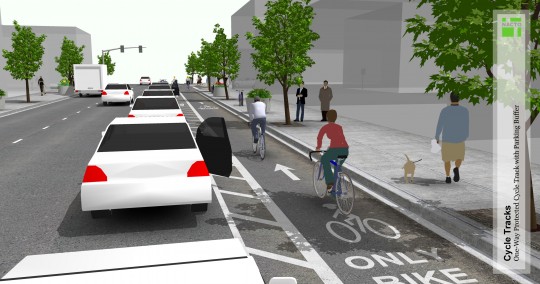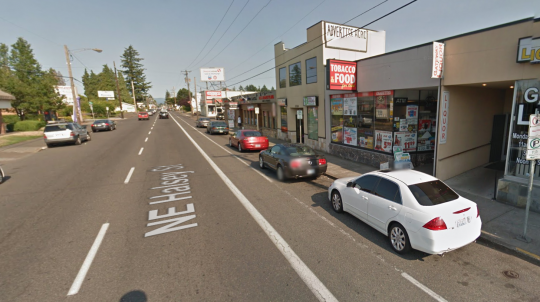
(Image: Urban Bikeway Design Guide)
If Gateway is ever going to get going, it’ll take tricks like this.
City planners have high hopes for this area on the inner edge of East Portland — literally. It’s zoned for downtown-style skyscrapers but (despite being fed by three MAX lines) currently devotes its real estate to gas stations, fast food joints and parking lots.
Still, some new investments have been popping up. If bigger ones are going to arrive, a lot is going to depend on how pleasant the city can make one of outer Northeast Portland’s few solid commercial districts: the half-mile stretch of Halsey and Weidler between 102nd and 112th avenues. That area is already home to a mini-mart, a string of independent bars and restaurants, a liquor store, a handful of other small employers and outer Northeast’s only independent bike shop, the Outer Rim.
Next week, the city will pitch a plan that would greatly improve biking on this couplet of one-way streets by upgrading the painted door-zone bike lanes there to parking-protected ones.
Reversing the bike lane and parking lane to create a more comfortable space to bike got its first experiment in Portland on SW Broadway near Portland State University in 2009. It’s since become part of the protected bike lanes on NE Cully Boulevard, NE Multnomah Street and SW Multnomah Boulevard and is used in many other cities around the country.
Advertisement

(Image: Google Street View)
The Halsey-Weidler couplet has a few challenges.
Visibility: The main drawback of parking-protected bike lanes is that cars are hard to see through, so there needs to be plenty of no-parking space near intersections and driveways where people driving can see if they’re about to turn in front of people biking.
Mis-parked cars: In order to get people to not park along the curb as usual, a parking-protected lane needs either a physical obstacle to prevent their doing so or at least an expectation that cars will be parked there continuously, so each person who arrives in a car will be able to copy someone who’s already parked.
Bus stops: Two TriMet buses, the 77 and 23, run along this stretch. When they stop to add or drop passengers, will they have any space to pull to the right? If they do, where will they stop? (Neither line is frequent, but the 77 is on TriMet’s list of routes to upgrade to frequent service when they’re able.) One option might be to move the bike lane to the left side of the street, but that might create an awkward transition wherever the left-side lane ends.
All of those problems can probably be solved, though. And if they are, this could be the first strip of storefronts in Portland that have a protected bike lane out front.
Replacing the current door-zone lanes and connecting to the curbside bike lane on 102nd would also be a major improvement of the biking network that’s supposed to one day spider outward from Gateway Transit Center.
The project’s open house is next Tuesday, Dec. 15, at Riverview Community Bank, 10401 NE Halsey. We’ll be eager to see exactly what the city proposes.
— Michael Andersen, (503) 333-7824 – michael@bikeportland.org

